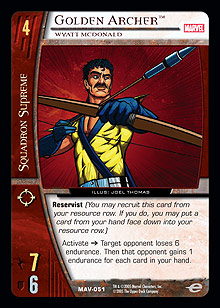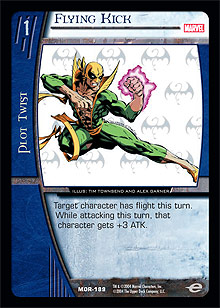
Welcome to the first installment of Theoretically Speaking. In this column, we will examine the concepts and difficult decisions that Vs. System presents to a competitive player.
Who am I and Why Do You Care What I Have to Say?
 Well, to answer those questions simply, my name is Shane Wiggans, I just finished second at Pro Circuit Atlanta, and I’ve won $32,000 playing Vs. System. But there is much more to me than just a name and a few dollars. Specifically, I have tattoos. Big ones. And that is just the tip of the iceberg.
Well, to answer those questions simply, my name is Shane Wiggans, I just finished second at Pro Circuit Atlanta, and I’ve won $32,000 playing Vs. System. But there is much more to me than just a name and a few dollars. Specifically, I have tattoos. Big ones. And that is just the tip of the iceberg.
I am a professional card player, but I believe that you can have a job or other priorities and still be successful in this game. Take me, for example. I am an attorney, I have a gorgeous fiance (I am getting married two weeks after Pro Circuit Indy), and I am a total nerd and card-playing fool.*
I have been moderately successful playing this game, but I really think it’s my happy-go-lucky attitude that gets me the most attention. Did you see that smile on my face when I shook Vidi’s hand at the end of the PC Atlanta? You would have thought I’d won the whole dang thing! Really, my teammates are the ones who deserve the most credit. Being a member of Team Alternate Win Condition is awesome. Everyone likes everyone, and it gives me free rein to make all the Tim Batow jokes I want!
So, after that brief introduction, let’s address those two questions again: who am I and why do you care what I have to say? I am a regular, down-to-Earth gamer who has learned through experience how to become a better player.
 When this column was first presented to me, I immediately thought, “Wow, this gives me a great opportunity to make jokes at Tim Batow’s expense, just like BigSpooky (Michael Barnes) in his column, Breaking Ground!” (End shameless plug.) How in the world could I turn down such an offer? I couldn’t! So, without further ado, here is the obligatory Tim Batow story:
When this column was first presented to me, I immediately thought, “Wow, this gives me a great opportunity to make jokes at Tim Batow’s expense, just like BigSpooky (Michael Barnes) in his column, Breaking Ground!” (End shameless plug.) How in the world could I turn down such an offer? I couldn’t! So, without further ado, here is the obligatory Tim Batow story:
It was 10:00 PM after a long and grueling Day 1 at Pro Circuit Atlanta. My teammate Jeremy Blair and I both had made Day 2 with 9-1 and 8-2 records, respectively. We had contacted another player who was in my first draft pod, Kyle Dembinski, to help us get a couple of practice drafts in before Day 2. So, we headed over to Kyle’s hotel. Jeremy, another teammate, and I were in one car, and the following car contained several local Oklahoma players and my teammate Tim Batow (a.k.a., Aqualad). We walked into the lobby and waited for Tim’s group to come in. After about five minutes of waiting, I called Tim, trying to figure out where they were. No answer. I called again about five minutes later and Tim answered, breathing heavily, saying that they were walking in as he spoke. Two seconds later, I saw Tim walk through the doors, drenched and wearing only his boxer shorts. For a second, I thought that I was hallucinating, but it was actually happening. He came running in, saying that one of the locals from Oklahoma had paid him $20 to jump into the pool naked. If any of you recall, the temperature was like thirty-five degrees over the course of the weekend, so he had to be freezing. When Tim walked in, several individuals began to take notice of our little group, especially Garth ◊ Aqualad. We quickly ran to the elevator, and Jeremy and I stood in front of Tim to hide him.** (I guess this is one of the few times it pays to be large and in charge, eh, Jeremy?) In the end, the joke was on us—we had gone to the wrong hotel, so we quickly had to get Tim to put his clothes back on so that we could leave before we got into serious trouble. Needless to say, after that, drafting was a little hard to concentrate on!
Many individuals, professionals, and casual players alike can agree that many games are won and lost during the formation step. Vs. System is complicated, and one of the most compelling reasons are the infinite options and difficult decisions that the formation step presents.
When I first started playing this game, I was told this little axiom to aid me in my formations: “Flight in the front, range in the rear.” While this theory is good for beginners and even casual players, a lot more thought and planning is required if you want to be competitive in this game. (Unfortunately, I do not have a nifty little rhyming device for characters that have both flight and range.)
The formation step is most likely the hardest thing for new players to understand when they try to learn Vs. System. During the build phase, you recruit characters that you will place at strategic spots during the formation step. During the combat phase, characters will be able to attack, reinforce, or use abilities in relation to where you placed them during the formation step. Simply put, formations are really important.
It’s funny how the decks that are the easiest to play often have the smallest number of characters in play. This is no coincidence. Having fewer characters in play eliminates the number of mistakes you can make. And many of those mistakes are either made in, or as a consequence of, your formation step.
For example, let’s look at the Squadron Supreme deck I played at Pro Circuit Atlanta during a typical turn 5 formation step.
Let’s assume that I have three characters in play:
Albert Gaines ◊ Nuke, Atomic Powerhouse
Golden Archer
Lady Lark, Skylark
 So, what are the thought processes that would go through my mind? First, all of my characters have range, so protecting one in the back row won’t limit my attack strategy at all. Second, Golden Archer has an activated ability and therefore potentially will not attack or be available for reinforcement. Third, I will need to consider carefully which characters need protection. If I put Lady Lark, Skylark in front of Golden Archer and she stuns either on attack or defense, then no one is left to protect Golden Archer from impending attacks should I choose to use his activated ability or reinforce.
So, what are the thought processes that would go through my mind? First, all of my characters have range, so protecting one in the back row won’t limit my attack strategy at all. Second, Golden Archer has an activated ability and therefore potentially will not attack or be available for reinforcement. Third, I will need to consider carefully which characters need protection. If I put Lady Lark, Skylark in front of Golden Archer and she stuns either on attack or defense, then no one is left to protect Golden Archer from impending attacks should I choose to use his activated ability or reinforce.
Those are just a few thoughts that enter my mind when considering my formations. Obviously, the endurance totals, cards in your hand, and potential cards in your opponent’s hand will also dictate your formations.
Now imagine the above example, but multiply the number of characters in play by three. That is what a player playing an X-Faces deck would have to consider during his or her formation step. It’s no wonder that most of the players who piloted X-Faces at PC Atlanta took their games to time. The decisions that they had to make during the formation step had to be mind-boggling! When selecting a deck, keep in mind that the more characters you put into play, the more options you’ll have, which in turn will create more scenarios that you must consider when forming up your characters.
Did I Tip My Hand?
How you choose to make your formations can have a huge impact on every game beyond simply dictating the row a character is in. Essentially, by placing characters at a certain position, you are giving your opponent information regarding possible attacks you may make, what plot twists you may have, whether or not you would consider reinforcing, and so on. A great example of this is leaving a character without range in the support row when you have the initiative. Immediately, a good player will start wondering: Was that a mistake on your part, or are you strategically placing that character there to utilize fully a plot twist like Rallying Cry! or Mega-Blast?
Likewise, if you do not have the initiative, you should be thinking like the imaginary player in the above example. What kind of deck is my opponent playing? Does it utilize cards like Flying Kick or Windstorm? Cards like these can break formations in half, allowing large amounts of breakthrough.
Don’t get me wrong—sometimes players make mistakes, but I am urging you not to respond to one player’s mistake with another. If you see something that looks a little odd, ask yourself a couple of questions. Is the questionable play easily overlookable? Are there plot twists available that would make the play beneficial? What plot twists has your opponent revealed to you during the course of the game? Do you have any tricks that would allow you to avoid potential traps, such as stunbacks or bouncing an attack? If you go through these questions, you will be better prepared for what may happen and less likely to respond with a hasty and possibly bad decision.
Probably the biggest mistake I see most often at premier-level events is fast play. Remember this one piece of advice if you remember any:
Pace yourself during formations.
I find it humorous that what is arguably the most important phase in the game is often completed the quickest. This is not a game of who can finish first. I understand that some decks, such as Anti-Green Lantern, are designed for speed, but even with those it is important to place your characters carefully.
By taking your time during formations and considering all the information that your opponent has revealed to you, you are making an informed decision. Trust me when I say that an informed decision is better than a quick one. I know that may sound trite and that many of you are saying, “Boring! Tell us something we don’t know, Shane,” but players forget that more often than you may think.
Playing at a highly competitive level such as at a Pro Circuit or a $10K can get your adrenaline going. Maybe you topdeck your drop, or your opponent misses his or hers, or you hit that game-winning tech, and in your jubilation, you make an error that could have been prevented if you had been cool and collected and made that informed decision. I am just trying to play the Papa Bear here and tell you to remember the basics!
“Yeah, Pam, Information is Power.”***
In the end, players should try to consider everything that their opponents have revealed to them in their decks. Do not be afraid to look through an opponent’s KO’d pile. The information gathered from plot twists that an opponent has already played can really aid you as you consider where to put your characters.
 For example, in a Squadron Supreme deck, if your opponent already has two s in his or her KO’d pile, no cards in hand, and only two face-down resources, the chances of your opponent having another Flying Kick in the row are unlikely. Likewise, if you are playing the same opponent, but instead there are no combat pumps in the KO’d pile and four face-down resources, you may need to consider your formations with regard to the possibility of an Ape X flying into your support row.
For example, in a Squadron Supreme deck, if your opponent already has two s in his or her KO’d pile, no cards in hand, and only two face-down resources, the chances of your opponent having another Flying Kick in the row are unlikely. Likewise, if you are playing the same opponent, but instead there are no combat pumps in the KO’d pile and four face-down resources, you may need to consider your formations with regard to the possibility of an Ape X flying into your support row.
Think about it in these terms: If you know exactly what cards your opponent plays, you will be better equipped to predict his or her behavior and will therefore have a better understanding of what is required to overcome his or her moves. It’s no coincidence that when you watch a feature match at a PC or a $10K, you see players quickly scribbling down any cards their opponents reveal. (Ironically, most of the time, these notes are unreadable to the naked eye.) These players know how to make the most of what their opponents give them and make them pay for it.
Here is a small list of cards that can really cause players headaches in Silver Age:
Prismatic Shield, Catcher’s Mitt, Rick Jones, Funeral for a Friend: A character left in an un-reinforceable position is like cake to a fat man. Players love it. Having any of these cards can effectively allow you to fool an opponent into thinking you made a mistake by leaving a character without reinforcement.
Flying Kick, Windstorm, Airskimmer, Rallying Cry!: These cards should be in the forefront of every player’s mind as they begin to test for Silver Age. They will most likely see play and should be considered carefully when making your formations.
Sabretooth, Savage Killer; Insect Swarm; Caliban: These cards are unique in that they allow an opponent to attack an area that you would normally not worry about. But you should at least consider these options in formations and not neglect your hidden friends (especially in a Hellfire Club deck!).
Banished to the Anti-Matter Universe, Silver Sorceress, Play Time: These cards are really interesting. They actually can disrupt a good formation and turn it into a bad one. If you run into a deck that may be playing cards with effects like these, carefully consider where to place your characters and how important protecting certain characters is given the situation.
The formation step is possibly one of the most difficult aspects of this game, and while I think I imparted some valuable knowledge, I was by no means exhaustive. Each and every deck will present a multitude of different decisions. But if you try to apply some of the concepts I laid out for you above, I am sure you will be well on your way to making a correct formation. If not, tell your opponents a big tattooed guy told you to form up that way, and if they have a problem, they can talk to me!
If you have any questions or comments, or if you would like to drop me a line, you can reach me at piercedlawyer@yahoo.com. I will try to take the anti–Michael Barnes approach and return emails rapidly.
* Believe me when I say “nerd.” I don’t drink, I don’t smoke; I sit around with my girl and watch reality TV.
** This was a double whammy, as we “protected” Tim as a character would protect a character in the support row (hence theme synergy . . . a thank you goes out to my twelfth grade English teacher), and it’s a signature Tim Batow small stature joke!
*** This quote is from my favorite show on TV, The Office. If you aren’t watching this show, well, you should start!